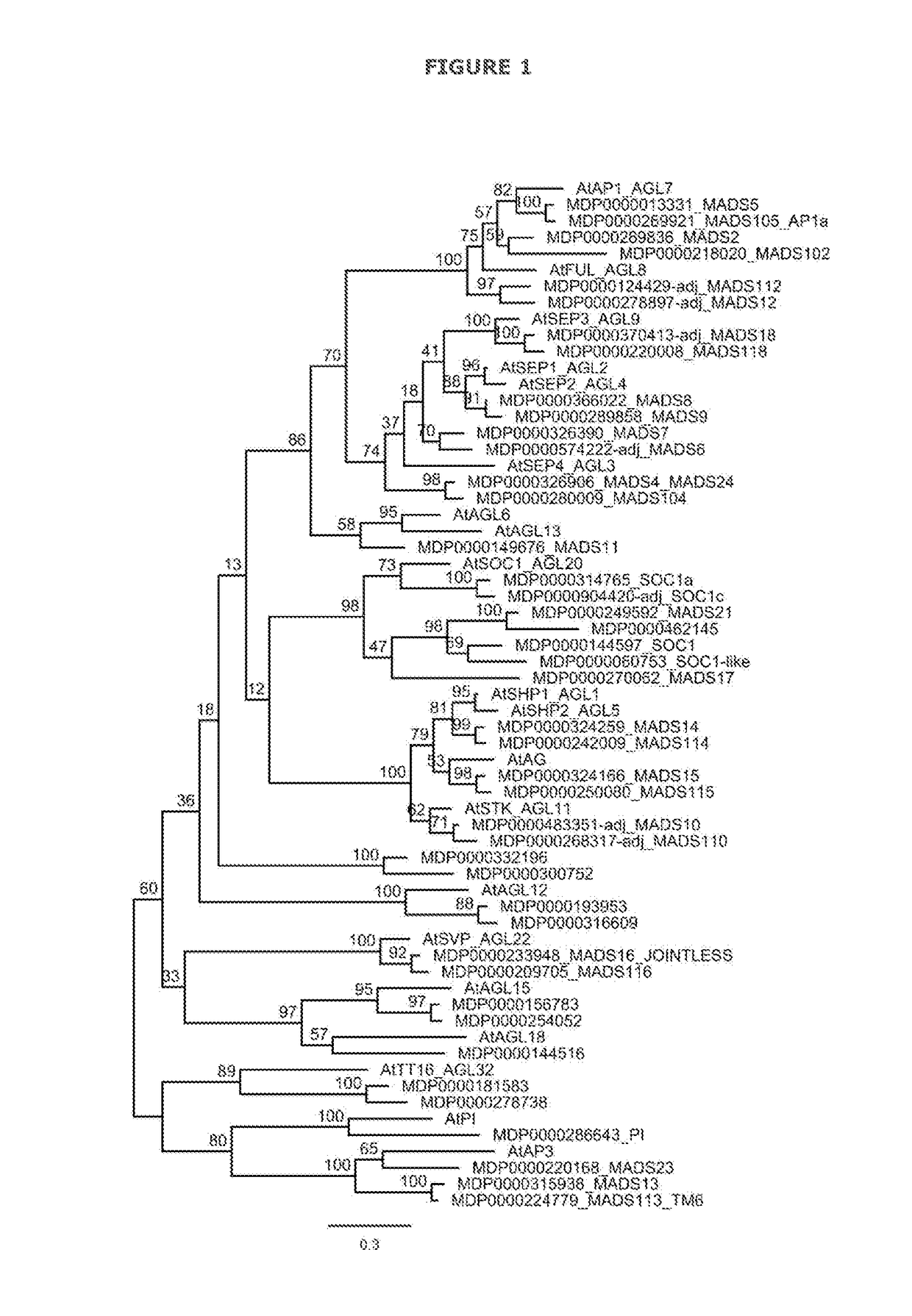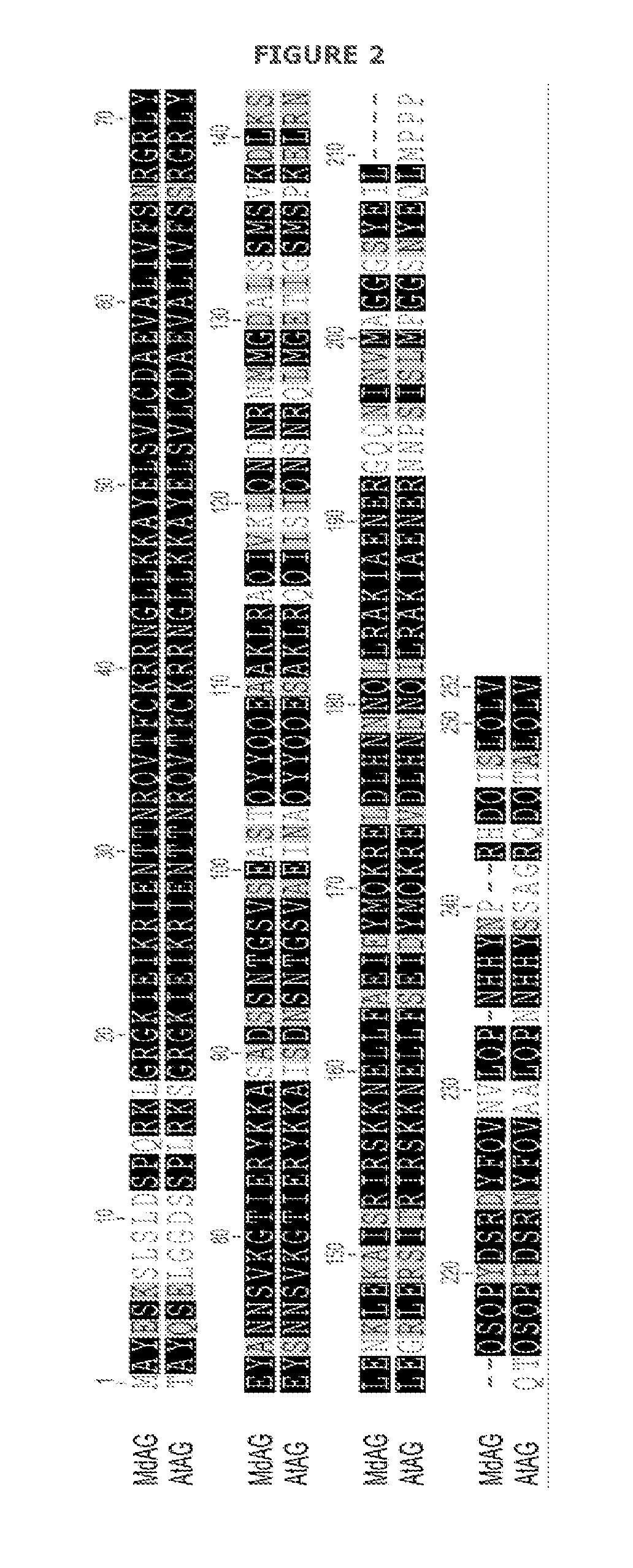Methods and Materials for Producing Coreless Fruit
a technology of fruits and cores, applied in the field of methods and materials for producing coreless fruits, can solve the problems of difficult digestion, inconvenience for humans, and unpleasant eating for humans
- Summary
- Abstract
- Description
- Claims
- Application Information
AI Technical Summary
Benefits of technology
Problems solved by technology
Method used
Image
Examples
example 1
Production of Coreless Fruit by Reducing Expression of the Agamous (AG) Gene and Hormone Application
[0438]Gene Identification
[0439]The AG cluster in Arabidopsis consists of 4 genes which are AG, SEEDSTICK (STK) and SHATTERPROOF (SHP) 1 and 2. The ancient genome duplication in apples means that for each of these Arabidopsis genes there are two similar apple genes
[0440]Using the apple genome (Velasco et al., 2010), apples MDP0000324166 and a homeologous gene MDP0000250080) are the most similar to Arabidopsis AG (atAG), see FIG. 1.
[0441]The first MDP0000324166, has been published as MADS15 (SEQ ID NO:30, van der Linden et al., 2002) The DNA sequence encoding MADS15 is shown in SEQ ID NO:31).
[0442]The applicants identified the equivalent gene for the apple cultivar Royal Gala, and designated this gene MdAG. The sequence of the MdAG protein and the polynucleotide encoding the protein are shown in SEQ ID NO: 1 and 4 respectively
[0443]An alignment of MdAG and AtAG proteins is shown in FIG....
example 2
Production of Coreless Fruit by Reducing Expression of AG and AP3-Like Genes
[0467]It will be understood by those skilled in the art that apple plants that do no express AP3-like genes are parthenocarpic (Yao et al. 2001). Therefore in accordance with the present invention, suppression of both AG and AP3-like genes (to induce parthenocarpy) results in plants than produce coreless fruit.
[0468]Hairpin Construct for Suppressing AP3-Like Genes
[0469]To suppress the two apple AP3-like genes, MdMADS13 and MdTm6, a hairpin construct containing the first 414 bp (ATATATCAAGTAAAACAAGATCAGAAAATTGCTAGGAAAAGGTAAGAAATTTGAGAGAG AGAGAGAAATTATGGGTCGTGGGAAGATTGAAATCAAGCTGATCGAAAACCAGACCAAC AGGCAGGTGACCTACTCCAAGAGAAGAAATGGGATCTTCAAGAAGGCTCAGGAGCTCAC CGTTCTCTGTGATGCCAAGGTCTCCCTCATTATGCTCTCCAACACTAATAAAATGCACGA GTATATCAGCCCTACCACTACGACCAAGAGTATGTATGATGACTATCAGAAAACTATGGG GATCGATCTGTGGAGGACACACGAGGAGTCGATGAAAGACACCTTGTGGAAGTTGAAAG AGATCAACAATAAGCTGAGGAGAGAGATCAGGCAGAGGTTGGGCCATGATCTAAATGG—SEQ ID NO:28) of ...
example 3
Production of Coreless Fruit by Reducing Expression of AG and PI Genes
[0474]It will be understood by those skilled in the art that apple plants that do no express PI genes are parthenocarpic (Yao et al. 2001). Therefore according to the invention, suppression of both AG and PI genes results in plants than produce coreless fruit.
[0475]Hairpin Construct for Suppressing PI Genes
[0476]To suppress the two apple MdPI, a hairpin construct containing the first 414 bp (ATGGGACGTGGGAAGGTTGAGATCAAGAGGATTGAGAACTCAAGTAACAGGCAGGTGA CCTACTCCAAGAGGAGGAATGGGATTATCAAGAAGGCAAAGGAGATCACTGTTCTATGT GATGCTAAAGTATCTCTTATCATTTATTCTAGCTCTGGGAAGATGGTTGAATACTGCAGC CCTTCAACTACGCTGACAGAAATCTTGGACAAATACCATGGACAATCTGGGAAGAAGTTG TGGGATGCTAAGCATGAGAACCTCAGCAATGAAGTGGATAGAGTCAAGAAAGACAATGA CAGCATGCAAGTAGAGCTCAGGCATCTGAAGGGAGAGGATATCACATCATTGAACCATG TAGAGCTGATGGCCTTAGAGGAAGCACTTGAAAATGGCCTTACAAGTATCCGGGACAAG—SEQ ID NO:29) of MdPI (SEQ ID NO:20) can be cloned into pDONOR (Invitrogen) and inserted into the gateway compa...
PUM
| Property | Measurement | Unit |
|---|---|---|
| length | aaaaa | aaaaa |
| concentration | aaaaa | aaaaa |
| strength | aaaaa | aaaaa |
Abstract
Description
Claims
Application Information
 Login to View More
Login to View More - R&D
- Intellectual Property
- Life Sciences
- Materials
- Tech Scout
- Unparalleled Data Quality
- Higher Quality Content
- 60% Fewer Hallucinations
Browse by: Latest US Patents, China's latest patents, Technical Efficacy Thesaurus, Application Domain, Technology Topic, Popular Technical Reports.
© 2025 PatSnap. All rights reserved.Legal|Privacy policy|Modern Slavery Act Transparency Statement|Sitemap|About US| Contact US: help@patsnap.com



